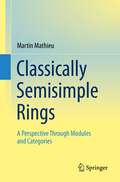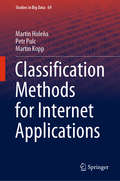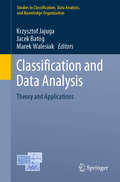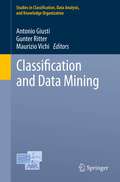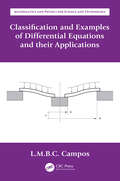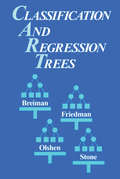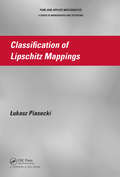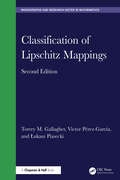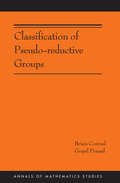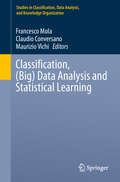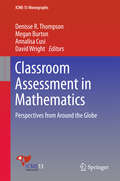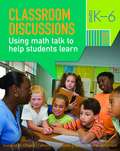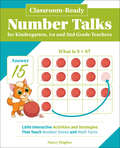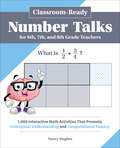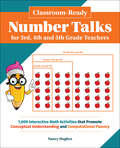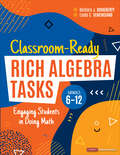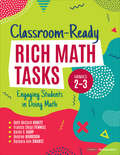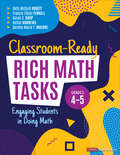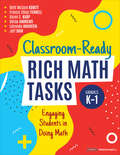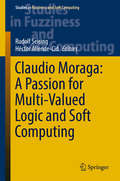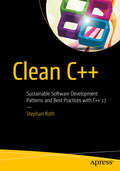- Table View
- List View
Classically Semisimple Rings: A Perspective Through Modules and Categories
by Martin MathieuClassically Semisimple Rings is a textbook on rings, modules and categories, aimed at advanced undergraduate and beginning graduate students.The book presents the classical theory of semisimple rings from a modern, category-theoretic point of view. Examples from algebra are used to motivate the abstract language of category theory, which then provides a framework for the study of rings and modules, culminating in the Wedderburn–Artin classification of semisimple rings. In the last part of the book, readers are gently introduced to related topics such as tensor products, exchange modules and C*-algebras. As a final flourish, Rickart’s theorem on group rings ties a number of these topics together. Each chapter ends with a selection of exercises of varying difficulty, and readers interested in the history of mathematics will find biographical sketches of important figures scattered throughout the text.Assuming previous knowledge in linear and basic abstract algebra, this book can serve as a textbook for a course in algebra, providing students with valuable early exposure to category theory.
Classification Methods for Internet Applications (Studies in Big Data #69)
by Martin Holeňa Petr Pulc Martin KoppThis book explores internet applications in which a crucial role is played by classification, such as spam filtering, recommender systems, malware detection, intrusion detection and sentiment analysis. It explains how such classification problems can be solved using various statistical and machine learning methods, including K nearest neighbours, Bayesian classifiers, the logit method, discriminant analysis, several kinds of artificial neural networks, support vector machines, classification trees and other kinds of rule-based methods, as well as random forests and other kinds of classifier ensembles. The book covers a wide range of available classification methods and their variants, not only those that have already been used in the considered kinds of applications, but also those that have the potential to be used in them in the future. The book is a valuable resource for post-graduate students and professionals alike.
Classification and Data Analysis: Theory and Applications (Studies in Classification, Data Analysis, and Knowledge Organization)
by Krzysztof Jajuga Jacek Batóg Marek WalesiakThis volume gathers peer-reviewed contributions on data analysis, classification and related areas presented at the 28th Conference of the Section on Classification and Data Analysis of the Polish Statistical Association, SKAD 2019, held in Szczecin, Poland, on September 18–20, 2019. Providing a balance between theoretical and methodological contributions and empirical papers, it covers a broad variety of topics, ranging from multivariate data analysis, classification and regression, symbolic (and other) data analysis, visualization, data mining, and computer methods to composite measures, and numerous applications of data analysis methods in economics, finance and other social sciences. The book is intended for a wide audience, including researchers at universities and research institutions, graduate and doctoral students, practitioners, data scientists and employees in public statistical institutions.
Classification and Data Mining (Studies in Classification, Data Analysis, and Knowledge Organization #0)
by Maurizio Vichi Antonio Giusti Gunter RitterThis volume contains both methodological papers showing new original methods, and papers on applications illustrating how new domain-specific knowledge can be made available from data by clever use of data analysis methods. The volume is subdivided in three parts: Classification and Data Analysis; Data Mining; and Applications. The selection of peer reviewed papers had been presented at a meeting of classification societies held in Florence, Italy, in the area of "Classification and Data Mining".
Classification and Examples of Differential Equations and their Applications (Mathematics and Physics for Science and Technology)
by Luis Manuel Braga da Costa CamposClassification and Examples of Differential Equations and their Applications is the sixth book within Ordinary Differential Equations with Applications to Trajectories and Vibrations, Six-volume Set. As a set, they are the fourth volume in the series Mathematics and Physics Applied to Science and Technology. This sixth book consists of one chapter (chapter 10 of the set). It contains 20 examples related to the preceding five books and chapters 1 to 9 of the set. It includes two recollections: the first with a classification of differential equations into 500 standards and the second with a list of 500 applications. The ordinary differential equations are classified in 500 standards concerning methods of solution and related properties, including: (i) linear differential equations with constant or homogeneous coefficients and finite difference equations; (ii) linear and non-linear single differential equations and simultaneous systems; (iii) existence, unicity and other properties; (iv) derivation of general, particular, special, analytic, regular, irregular, and normal integrals; (v) linear differential equations with variable coefficients including known and new special functions. The theory of differential equations is applied to the detailed solution of 500 physical and engineering problems including: (i) one- and multidimensional oscillators, with damping or amplification, with non-resonant or resonant forcing; (ii) single, non-linear, and parametric resonance; (iii) bifurcations and chaotic dynamical systems; (iv) longitudinal and transversal deformations and buckling of bars, beams, and plates; (v) trajectories of particles; (vi) oscillations and waves in non-uniform media, ducts, and wave guides. Provides detailed solution of examples of differential equations of the types covered in tomes l-5 of the set (Ordinary Differential Equations with Applications to Trajectories and Vibrations, Six -volume Set) Includes physical and engineering problems that extend those presented in the tomes 1-6 (Ordinary Differential Equations with Applications to Trajectories and Vibrations, Six-volume Set) Includes a classification of ordinary differential equations and their properties into 500 standards that can serve as a look-up table of methods of solution Covers a recollection of 500 physical and engineering problems and sub-cases that involve the solution of differential equations Presents the problems used as examples including formulation, solution, and interpretation of results
Classification and Regression Trees
by Leo BreimanThe methodology used to construct tree structured rules is the focus of this monograph. Unlike many other statistical procedures, which moved from pencil and paper to calculators, this text's use of trees was unthinkable before computers. Both the practical and theoretical sides have been developed in the authors' study of tree methods. Classification and Regression Trees reflects these two sides, covering the use of trees as a data analysis method, and in a more mathematical framework, proving some of their fundamental properties.
Classification of Lipschitz Mappings (Chapman & Hall/CRC Monographs and Research Notes in Mathematics)
by Lukasz PiaseckiClassification of Lipschitz Mappings presents a systematic, self-contained treatment of a new classification of Lipschitz mappings and its application in many topics of metric fixed point theory. Suitable for readers interested in metric fixed point theory, differential equations, and dynamical systems, the book only requires a basic background in
Classification of Lipschitz Mappings (Chapman & Hall/CRC Monographs and Research Notes in Mathematics)
by Torrey M. Gallagher Víctor Pérez-García Łukasz PiaseckiClassification of Lipschitz Mappings, Second Edition presents a systematic, self-contained treatment of a new classification of Lipschitz mappings and its applications, particularly to metric fixed point theory. Suitable for readers interested in nonlinear analysis, metric fixed point theory, differential equations, ergodic theory, and dynamical systems, the book requires only a basic background in functional analysis and topology, and should therefore be accessible to graduate students or advanced undergraduates, as well as to professionals looking for new topics in metric fixed point theory.In particular, the second edition contains results related to: Regulating the growth of the sequence of Lipschitz constants k(Tn) Ensuring good estimates for k0(T) and k∞(T) Studying moving harmonic and geometric averages as well as generalized Fibonacci-type sequences and their application to provide a new algorithm for solving polynomials in the real case and in Banach algebras Classifying mean isometries and mean contractions Generalizing Browder’s famous Demiclosedness Principle Providing some new results in metric fixed point theory Minimal displacement and optimal retraction problems
Classification of Pseudo-reductive Groups (AM-191)
by Brian Conrad Gopal PrasadIn the earlier monograph Pseudo-reductive Groups, Brian Conrad, Ofer Gabber, and Gopal Prasad explored the general structure of pseudo-reductive groups. In this new book, Classification of Pseudo-reductive Groups, Conrad and Prasad go further to study the classification over an arbitrary field. An isomorphism theorem proved here determines the automorphism schemes of these groups. The book also gives a Tits-Witt type classification of isotropic groups and displays a cohomological obstruction to the existence of pseudo-split forms. Constructions based on regular degenerate quadratic forms and new techniques with central extensions provide insight into new phenomena in characteristic 2, which also leads to simplifications of the earlier work. A generalized standard construction is shown to account for all possibilities up to mild central extensions.The results and methods developed in Classification of Pseudo-reductive Groups will interest mathematicians and graduate students who work with algebraic groups in number theory and algebraic geometry in positive characteristic.
Classification, (Studies In Classification, Data Analysis, And Knowledge Organization Ser.)
by Maurizio Vichi Francesco Mola Claudio ConversanoThis edited book focuses on the latest developments in classification, statistical learning, data analysis and related areas of data science, including statistical analysis of large datasets, big data analytics, time series clustering, integration of data from different sources, as well as social networks. It covers both methodological aspects as well as applications to a wide range of areas such as economics, marketing, education, social sciences, medicine, environmental sciences and the pharmaceutical industry. In addition, it describes the basic features of the software behind the data analysis results, and provides links to the corresponding codes and data sets where necessary. This book is intended for researchers and practitioners who are interested in the latest developments and applications in the field. The peer-reviewed contributions were presented at the 10th Scientific Meeting of the Classification and Data Analysis Group (CLADAG) of the Italian Statistical Society, held in Santa Margherita di Pula (Cagliari), Italy, October 8–10, 2015.
Classroom Assessment in Mathematics: Perspectives From Around The Globe (ICME-13 Monographs)
by David Wright Denisse R. Thompson Megan Burton Annalisa CusiThis book consists of 13 papers developed by participants in the ICME 13 Topic Study Group 40 on Classroom Assessment. The individual papers discuss various aspects of classroom assessment, focusing particularly on formative assessment as assessment for learning, and are grouped into four main sections: Examples of Classroom Assessment in Action, Technology as a Tool for Classroom Assessment, Statistical Models for Formative Assessment, and Engaging Teachers in Formative Assessment. The book opens with a brief discussion of the use of formative assessment as a critical component of the teaching–learning process and concludes with an overview of lessons learned and ideas for future research. It is of interest to classroom teachers, university teacher educators, professional development providers and school supervisors.
Classroom Discussions: Using Math Talk to Help Students Learn, Grades K-6 (2nd edition)
by Catherine O'Connor Suzanne H. Chapin Nancy Canavan AndersonThis best-selling resource offers an unparalleled look at the significant role that classroom discussions can play in teaching mathematics. New to this edition are more research-based examples of classroom talk at early grade levels, an expanded range of vignettes, discussion questions at the end of each chapter, and connections to NCTM standards.
Classroom-Ready Number Talks for Kindergarten, First and Second Grade Teachers: 1,000 Interactive Activities and Strategies that Teach Number Sense and Math Facts (Books for Teachers)
by Nancy HughesA wide variety of ready-to-use number talks that help kindergarten through second-grade students learn math concepts in fun and easy ways.Bringing the exciting teaching method of number talks into your classroom has never been easier. Simply choose from the hundreds of great ideas in this book and get going!From activities on addition and subtraction to fractions and decimals, Classroom-Ready Number Talks for Kindergarten, First and Second Grade Teachers includes:Grade-level specific strategiesNumber talk how-tosVisual and numerical examplesScaffolding suggestionsCommon core alignmentsQuestions to build understandingReduce time spent lesson-planning and preparing materials and enjoy more time engaging your students in learning important math concepts! These ready-to-use number talks are sure to foster a fresh and exciting learning environment in your classroom, as well as help your students increase their comprehension of numbers and mathematical principles.
Classroom-Ready Number Talks for Sixth, Seventh, and Eighth Grade Teachers: 1,000 Interactive Math Activities That Promote Conceptual Understanding and Computational Fluency (Books For Teachers Ser.)
by Nancy HughesThe fun way to teach middle schoolers the mental math, problem-solving skills they need to meet common core standards and attain mathematical fluency. Bringing the exciting teaching method of number talks into your classroom has never been easier. Simply choose from the hundreds of great ideas in this book and get going, with no extra time wasted! From activities on multiplication and division to decimals and integers, Classroom-Ready Number Talks for Sixth, Seventh, and Eighth Grade Teachers includes:Grade-level specific strategiesNumber talk how-tosVisual and numerical examplesScaffolding suggestionsCommon core alignmentsQuestions to build understandingReduce time spent lesson planning and preparing materials and enjoy more time engaging your students in learning important math concepts! These ready-to-use number talks are sure to foster a fresh and exciting learning environment in your classroom.
Classroom-Ready Number Talks for Third, Fourth and Fifth Grade Teachers: 1,000 Interactive Math Activities that Promote Conceptual Understanding and Computational Fluency (Books for Teachers)
by Nancy HughesA huge collection of ready-to-use number talks that make math concepts easier for students to learn.Whether you’re new to number talks or have been using them in your classroom for years, this book makes it easier than ever for your students to experience this exciting teaching method. Instead of trying to come up with a new number talk every day, simply select one of the hundreds of great offerings provided in this book.With chapters on addition, subtraction, multiplication, division, fractions and decimals, Classroom-Ready Number Talks for 3rd, 4th and 5th Grade Teachers includes:• Grade-level specific strategies• Number talk how-tos• Visual and numerical examples• Scaffolding suggestions• Common core alignments• Questions to build understandingWith these ready-to-use number talks, you’ll reduce time spent lesson-planning and enjoy more time discussing math with your students. It’s sure to create a more engaging environment in your classroom and increase student comprehension of math concepts and how numbers function in the world around them.
Classroom-Ready Rich Algebra Tasks, Grades 6-12: Engaging Students in Doing Math (Corwin Mathematics Series)
by Barbara J. Dougherty Linda C. VenencianoStop algebra from being a mathematical gatekeeper. With rich math tasks, all students can succeed. Every teacher strives to make instruction effective and interesting, yet traditional methods of teaching algebra are not working for many students! That’s a problem. But the answer isn’t to supplement the curriculum with random tasks. Classroom Ready-Rich Math Tasks for Grades 6-12 equips you with a cohesive solution--50+ mathematical tasks that are rich, research-based, standards-aligned, and classroom-tested. The tasks: Are organized into learning progressions that help all students make the leap from arithmetic to algebra Offer students interesting mathematics problems to think about and solve so math is investigative, interactive, and engaging Provide opportunities for you to connect new content to prior knowledge or focus on an underdeveloped concept Engage students in conceptual understanding, procedural practice, and problem solving through critical thinking and application Come with downloadable planning tools, student resource pages, and extension questions Include additional support for students who may be struggling Every learner deserves opportunities to engage in meaningful, rigorous mathematics. And every teacher can develop mathematical thinking and reasoning abilities in students. Part of the bestselling series spanning elementary and middle school, Classroom-Ready Rich Algebra Tasks, Grades 6-12 is a powerful add-on to any core mathematics program at your school.
Classroom-Ready Rich Algebra Tasks, Grades 6-12: Engaging Students in Doing Math (Corwin Mathematics Series)
by Barbara J. Dougherty Linda C. VenencianoStop algebra from being a mathematical gatekeeper. With rich math tasks, all students can succeed. Every teacher strives to make instruction effective and interesting, yet traditional methods of teaching algebra are not working for many students! That’s a problem. But the answer isn’t to supplement the curriculum with random tasks. Classroom Ready-Rich Math Tasks for Grades 6-12 equips you with a cohesive solution--50+ mathematical tasks that are rich, research-based, standards-aligned, and classroom-tested. The tasks: Are organized into learning progressions that help all students make the leap from arithmetic to algebra Offer students interesting mathematics problems to think about and solve so math is investigative, interactive, and engaging Provide opportunities for you to connect new content to prior knowledge or focus on an underdeveloped concept Engage students in conceptual understanding, procedural practice, and problem solving through critical thinking and application Come with downloadable planning tools, student resource pages, and extension questions Include additional support for students who may be struggling Every learner deserves opportunities to engage in meaningful, rigorous mathematics. And every teacher can develop mathematical thinking and reasoning abilities in students. Part of the bestselling series spanning elementary and middle school, Classroom-Ready Rich Algebra Tasks, Grades 6-12 is a powerful add-on to any core mathematics program at your school.
Classroom-Ready Rich Math Tasks, Grades 2-3: Engaging Students in Doing Math (Corwin Mathematics Series)
by Karen S. Karp Beth McCord Kobett Francis M. Fennell Barbara Ann Swartz Desiree Yvonne HarrisonDetailed plans for helping elementary students experience deep mathematical learning Do you work tirelessly to make your math lessons meaningful, challenging, accessible, and engaging? Do you spend hours you don’t have searching for, adapting, and creating tasks to provide rich experiences for your students that supplement your mathematics curriculum? Help has arrived! Classroom Ready-Rich Math Tasks for Grades 2-3 details research- and standards-aligned, high-cognitive-demand tasks that will have your students doing deep-problem-based learning. These ready-to-implement, engaging tasks connect skills, concepts and practices, while encouraging students to reason, problem-solve, discuss, explore multiple solution pathways, connect multiple representations, and justify their thinking. They help students monitor their own thinking and connect the mathematics they know to new situations. In other words, these tasks allow students to truly do mathematics! Written with a strengths-based lens and an attentiveness to all students, this guide includes: • Complete task-based lessons, referencing mathematics standards and practices, vocabulary, and materials • Downloadable planning tools, student resource pages, and thoughtful questions, and formative assessment prompts • Guidance on preparing, launching, facilitating, and reflecting on each task • Notes on access and equity, focusing on students’ strengths, productive struggle, and distance or alternative learning environments. With concluding guidance on adapting or creating additional rich tasks for your students, this guide will help you give all of your students the deepest, most enriching and engaging mathematics learning experience possible.
Classroom-Ready Rich Math Tasks, Grades 2-3: Engaging Students in Doing Math (Corwin Mathematics Series)
by Karen S. Karp Beth McCord Kobett Francis M. Fennell Barbara Ann Swartz Desiree Yvonne HarrisonDetailed plans for helping elementary students experience deep mathematical learning Do you work tirelessly to make your math lessons meaningful, challenging, accessible, and engaging? Do you spend hours you don’t have searching for, adapting, and creating tasks to provide rich experiences for your students that supplement your mathematics curriculum? Help has arrived! Classroom Ready-Rich Math Tasks for Grades 2-3 details research- and standards-aligned, high-cognitive-demand tasks that will have your students doing deep-problem-based learning. These ready-to-implement, engaging tasks connect skills, concepts and practices, while encouraging students to reason, problem-solve, discuss, explore multiple solution pathways, connect multiple representations, and justify their thinking. They help students monitor their own thinking and connect the mathematics they know to new situations. In other words, these tasks allow students to truly do mathematics! Written with a strengths-based lens and an attentiveness to all students, this guide includes: • Complete task-based lessons, referencing mathematics standards and practices, vocabulary, and materials • Downloadable planning tools, student resource pages, and thoughtful questions, and formative assessment prompts • Guidance on preparing, launching, facilitating, and reflecting on each task • Notes on access and equity, focusing on students’ strengths, productive struggle, and distance or alternative learning environments. With concluding guidance on adapting or creating additional rich tasks for your students, this guide will help you give all of your students the deepest, most enriching and engaging mathematics learning experience possible.
Classroom-Ready Rich Math Tasks, Grades 4-5: Engaging Students in Doing Math (Corwin Mathematics Series)
by Karen S. Karp Beth McCord Kobett Francis M. Fennell Delise R. Andrews Sorsha-Maria T. MulroeDetailed plans for helping elementary students experience deep mathematical learning Do you work tirelessly to make your math lessons meaningful, challenging, accessible, and engaging? Do you spend hours you don’t have searching for, adapting, and creating tasks to provide rich experiences for your students that supplement your mathematics curriculum? Help has arrived! Classroom Ready-Rich Math Tasks for Grades 4-5 details more than 50 research- and standards-aligned, high-cognitive-demand tasks that will have your students doing deep-problem-based learning. These ready-to-implement, engaging tasks connect skills, concepts and practices, while encouraging students to reason, problem-solve, discuss, explore multiple solution pathways, connect multiple representations, and justify their thinking. They help students monitor their own thinking and connect the mathematics they know to new situations. In other words, these tasks allow students to truly do mathematics! Written with a strengths-based lens and an attentiveness to all students, this guide includes: • Complete task-based lessons, referencing mathematics standards and practices, vocabulary, and materials • Downloadable planning tools, student resource pages, and thoughtful questions, and formative assessment prompts • Guidance on preparing, launching, facilitating, and reflecting on each task • Notes on access and equity, focusing on students’ strengths, productive struggle, and distance or alternative learning environments. With concluding guidance on adapting or creating additional rich tasks for your students, this guide will help you give all of your students the deepest, most enriching and engaging mathematics learning experience possible.
Classroom-Ready Rich Math Tasks, Grades 4-5: Engaging Students in Doing Math (Corwin Mathematics Series)
by Karen S. Karp Beth McCord Kobett Francis M. Fennell Delise R. Andrews Sorsha-Maria T. MulroeDetailed plans for helping elementary students experience deep mathematical learning Do you work tirelessly to make your math lessons meaningful, challenging, accessible, and engaging? Do you spend hours you don’t have searching for, adapting, and creating tasks to provide rich experiences for your students that supplement your mathematics curriculum? Help has arrived! Classroom Ready-Rich Math Tasks for Grades 4-5 details more than 50 research- and standards-aligned, high-cognitive-demand tasks that will have your students doing deep-problem-based learning. These ready-to-implement, engaging tasks connect skills, concepts and practices, while encouraging students to reason, problem-solve, discuss, explore multiple solution pathways, connect multiple representations, and justify their thinking. They help students monitor their own thinking and connect the mathematics they know to new situations. In other words, these tasks allow students to truly do mathematics! Written with a strengths-based lens and an attentiveness to all students, this guide includes: • Complete task-based lessons, referencing mathematics standards and practices, vocabulary, and materials • Downloadable planning tools, student resource pages, and thoughtful questions, and formative assessment prompts • Guidance on preparing, launching, facilitating, and reflecting on each task • Notes on access and equity, focusing on students’ strengths, productive struggle, and distance or alternative learning environments. With concluding guidance on adapting or creating additional rich tasks for your students, this guide will help you give all of your students the deepest, most enriching and engaging mathematics learning experience possible.
Classroom-Ready Rich Math Tasks, Grades K-1: Engaging Students in Doing Math (Corwin Mathematics Series)
by Karen S. Karp Beth McCord Kobett Francis M. Fennell Delise R. Andrews Latrenda Duretta Knighten Jeffrey Chen ShihDetailed plans for helping elementary students experience deep mathematical learning Do you work tirelessly to make your math lessons meaningful, challenging, accessible, and engaging? Do you spend hours you don’t have searching for, adapting, and creating tasks to provide rich experiences for your students that supplement your mathematics curriculum? Help has arrived! Classroom Ready-Rich Math Tasks for Grades K-1 details 56 research- and standards-aligned, high-cognitive-demand tasks that will have your students doing deep-problem-based learning. These ready-to-implement, engaging tasks connect skills, concepts and practices, while encouraging students to reason, problem-solve, discuss, explore multiple solution pathways, connect multiple representations, and justify their thinking. They help students monitor their own thinking and connect the mathematics they know to new situations. In other words, these tasks allow students to truly do mathematics! Written with a strengths-based lens and an attentiveness to all students, this guide includes: • Complete task-based lessons, referencing mathematics standards and practices, vocabulary, and materials • Downloadable planning tools, student resource pages, and thoughtful questions, and formative assessment prompts • Guidance on preparing, launching, facilitating, and reflecting on each task • Notes on access and equity, focusing on students’ strengths, productive struggle, and distance or alternative learning environments. With concluding guidance on adapting or creating additional rich tasks for your students, this guide will help you give all of your students the deepest, most enriching and engaging mathematics learning experience possible.
Classroom-Ready Rich Math Tasks, Grades K-1: Engaging Students in Doing Math (Corwin Mathematics Series)
by Karen S. Karp Beth McCord Kobett Francis M. Fennell Delise R. Andrews Latrenda Duretta Knighten Jeffrey Chen ShihDetailed plans for helping elementary students experience deep mathematical learning Do you work tirelessly to make your math lessons meaningful, challenging, accessible, and engaging? Do you spend hours you don’t have searching for, adapting, and creating tasks to provide rich experiences for your students that supplement your mathematics curriculum? Help has arrived! Classroom Ready-Rich Math Tasks for Grades K-1 details 56 research- and standards-aligned, high-cognitive-demand tasks that will have your students doing deep-problem-based learning. These ready-to-implement, engaging tasks connect skills, concepts and practices, while encouraging students to reason, problem-solve, discuss, explore multiple solution pathways, connect multiple representations, and justify their thinking. They help students monitor their own thinking and connect the mathematics they know to new situations. In other words, these tasks allow students to truly do mathematics! Written with a strengths-based lens and an attentiveness to all students, this guide includes: • Complete task-based lessons, referencing mathematics standards and practices, vocabulary, and materials • Downloadable planning tools, student resource pages, and thoughtful questions, and formative assessment prompts • Guidance on preparing, launching, facilitating, and reflecting on each task • Notes on access and equity, focusing on students’ strengths, productive struggle, and distance or alternative learning environments. With concluding guidance on adapting or creating additional rich tasks for your students, this guide will help you give all of your students the deepest, most enriching and engaging mathematics learning experience possible.
Claudio Moraga: A Passion for Multi-Valued Logic and Soft Computing (Studies in Fuzziness and Soft Computing #349)
by Rudolf Seising Héctor Allende-CidThe book is an authoritative collection of contributions by leading experts on the topics of fuzzy logic, multi-valued logic and neural network. Originally written as an homage to Claudio Moraga, seen by his colleagues as an example of concentration, discipline and passion for science, the book also represents a timely reference guide for advance students and researchers in the field of soft computing, and multiple-valued logic.
Clean C++: Sustainable Software Development Patterns and Best Practices with C++ 17
by Stephan RothWrite maintainable, extensible, and durable software with modern C++. This book is a must for every developer, software architect, or team leader who is interested in good C++ code, and thus also wants to save development costs. If you want to teach yourself about writing clean C++, Clean C++ is exactly what you need. It is written to help C++ developers of all skill levels and shows by example how to write understandable, flexible, maintainable, and efficient C++ code. Even if you are a seasoned C++ developer, there are nuggets and data points in this book that you will find useful in your work. If you don't take care with your code, you can produce a large, messy, and unmaintainable beast in any programming language. However, C++ projects in particular are prone to be messy and tend to slip into bad habits. Lots of C++ code that is written today looks as if it was written in the 1980s. It seems that C++ developers have been forg otten by those who preach Software Craftsmanship and Clean Code principles. The Web is full of bad, but apparently very fast and highly optimized C++ code examples, with cruel syntax that completely ignores elementary principles of good design and well-written code. This book will explain how to avoid this scenario and how to get the most out of your C++ code. You'll find your coding becomes more efficient and, importantly, more fun. What You'll Learn Gain sound principles and rules for clean coding in C++ Carry out test driven development (TDD) Discover C++ design patterns and idioms Apply these design patterns Who This Book Is For Any C++ developer and software engineer with an interest in producing better code.
